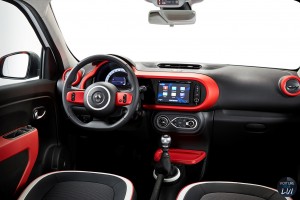The third-generation Renault Twingo may have a familiar name and the same pert and fun-to-drive qualities of its predecessors, but links with the past stop there. In every other respect it’s all-new and radically different, introducing a number of firsts for the model – a rear-mounted engine, rear-wheel drive and five doors.
In spirit and character it echoes the much-loved original Twingo of 1993 and the Renault 5 before that, but with its new layout and more practical body style it is very much a car for 21st-century cities – compact, nimble, efficient, safe and fully connected to the outside world.
The two new engines on offer bring substantial improvements in fuel economy and emissions compared with the previous model, culminating in the 67.3 mpg and 95 g/km of CO2 for the 1.0-litre Dynamique SCe 70 model with Stop & Start. This means the car can travel 14 miles further on every gallon of fuel while emitting 35 g/km less CO2.
The All-New Twingo is a clean-sheet-of-paper car which takes into account all the joys and stresses of living and driving in the cities it was primarily designed for. It is shorter and easier to park than its predecessor, more agile and greater fun to drive, more manoeuvrable with better all-round visibility, and simpler to get in and out of. And it exhibits substantial improvements in quality.
“The All-New Twingo rounds off the renewal of Renault’s small-car range. As a means to win over new customers, the stakes for the brand are as high as they were for the model’s predecessors. Putting the engine at the back is an ingenious concept, just as the original Twingo was. It is still small on the outside and big on the inside, but it now comes with a choice of two connected systems that ease driving in built-up areas, on top of its peerless manoeuvrability and agility.”
Ali Kassaï, Vice President, Small Car Programmes
The advantages of a rear engine
By mounting the engine at the rear, cars can be made shorter, which in turn means they fit into smaller parking spaces and are more nimble when nipping through traffic. The potential downside is that a rear-mounted engine can steal boot space, while people brought up on front-wheel-drive cars might worry about the handling implications and the consequences of being hit from behind.
Renault’s engineers and designers have overcome these obstacles ingeniously. The engine is mounted at an angle of 49 degrees so that it does not intrude into the boot, and in a rear-end collision it is pushed beneath the passenger cell. Fifty per cent of the engine parts have been redesigned so that the power unit takes up 15 cm less space than if it had been mounted vertically. Meanwhile, Electronic Stability Control overcomes any possibility of a rear-wheel skid in slippery conditions.
The All-New Twingo’s compact overall length and short overhangs endow it with a best-in-class turning circle of only 8.59 metres, aided by front wheels which turn 45 degrees. This outstanding agility makes the All-New Twingo much easier than the majority of cars to manoeuvre into kerbside parking spaces or end-on parking bays. The range-topping Dynamique TCe 90 and Dynamique S TCe 90 models also have Variable Gear Ratio steering requiring one-half turn less of the steering wheel compared to the SCe 70.
With its new layout, the third-generation Twingo is 10 cm shorter than its predecessor at 3.59 metres long, but has a 12 cm longer wheelbase (2.49 metres) and 33 cm more room in the four-seat cabin.























